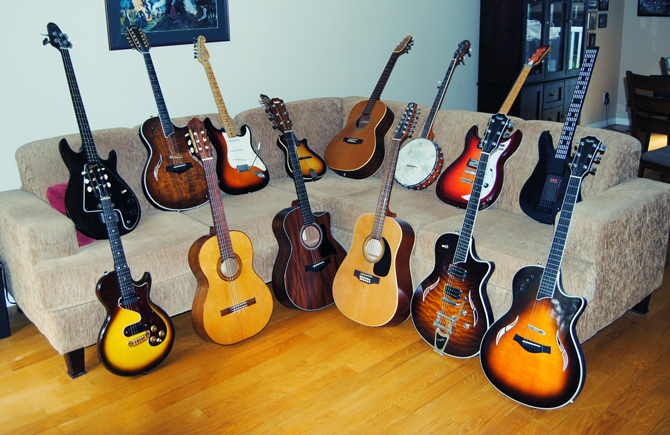When Robert Johnson died in 1938, he left us a total of two photos and 29 compositions. His life was shrouded in mystery and dominated by myths of demonic possession. His body was never found after his death and three different markers have been erected for him in church cemeteries around Greenwood, Mississippi. It was only when his death certificate was discovered in 1967 that details of his life began to emerge.
Johnson was born in Hazlehurst, Mississippi to Noah Johnson and Julia Dodds, whose husband Charles Dodds, a wealthy carpenter and farmer with whom Julia had had ten children, was forced to flee to Memphis to escape lynching at the hands of white landowners resentful of his success. Julia was left destitute and took up with a plantation worker who abused Robert for not working the fields while still a child. For a southern black man in the early part of the 20th century, there was little else to life but a boss and a plow. In spite of the theoretical emancipation of blacks achieved by the civil war, the real, jangling chains of slavery had gradually been replaced by poverty and racism. It was bondage by another name.
Musicians visited the plantations on weekends and offered men like Robert Johnson a view of what life without servitude could be like. However, to make money, musicians had to go to cities, where people had money. They travelled constantly, a very dangerous life for a black man in Mississippi, where killing or lynching happened regularly, often on no more than a whim. Musicians were also regarded as evil by most people because of the Church, which was extremely powerful among black Christian Americans. With the drinking, gambling, womanizing and blaspheming going on in every juke joint in the South, preachers and their fiery sermons quickly created the widely-held myth that the blues was the devil’s music.
When veteran bluesman (and ex-preacher) Son House moved to the Robinsonville area in 1930, he teamed up with local sideman Willie Brown, and young Robert Johnson was a fixture at their concerts ( Johnson mentions Willie Brown by name in his song “Cross Road Blues”, calling him “my good friend.”). Son House recalls that, at that time, Johnson was a horrible guitar player and people shouted him down whenever he tried to play.
It was at this time that Robert Johnson disappeared from the face of the Earth. No one knew where he went. On his return, he went back to the same juke joint where House and Brown were playing but this time, he completely bowled over the crowd when he made it up on stage. In a little more than a year, Robert Johnson had somehow become the greatest blues singer and guitarist anyone had ever heard. No one believed that he could have become that good in so little time. Rumours quickly spread that Johnson had gone to the crossroads to sell his soul to the devil in return for his incredible talents. A far more plausible explanation is that Johnson went back to Hazlehurst looking for his biological father, Noah Johnson, but instead found Isaiah “Ike” Zimmerman, the best guitarist in all of southern Mississippi at that time. Johnson stayed with Zimmerman’s family and the two practiced endlessly while sitting on tombstones in nearby Beauregard cemetery, no doubt adding fuel to the fire of Johnson’s rumoured dealings with the devil. His compositions also did nothing to dispel the myth, with titles like “Cross Road Blues”, “Hell Hound On My Trail” and “Me And The Devil.”
In addition to Robert Johnson’s remarkable new musicianship, he also came back a changed man. He was now that reckless, hard-drinking, womanizing bluesman endlessly admonished by the Church. Many point to his two failed attempts at a “normal” life, where his first wife, 15-year-old Virginia Travis, died in childbirth and, later on, Virgie Cain’s strict religious family would not tolerate their daughter associating with anyone playing “the devil’s music.” After these failures, Johnson’s life seems to have rushed head-on towards his fate: a juke joint called The Three Forks in Greenwood, Mississippi.
While playing there, Johnson had befriended the wife of a barman, who sought his revenge by giving Johnson a poisoned bottle of whiskey. Bluesmen David “Honeyboy” Edwards and Sonny Boy Williamson were both there that night and saw that the seal on the bottle had been broken. They tried to slap the bottle away from Johnson but he never said no to a bottle. He drank and was in agony for three days, dying on August 16, 1838, 81 years to this day. Robert Johnson was 27 years old.
All of Johnson’s compositions are a true reflection of life in the US south for a black man during the Great Depression. His lyrics are suffused with references to Hoodoo, the spiritual practices carried to the United States by West Africans as the result of the transatlantic slave trade. Hoodoo teaches that human well-being is governed by spiritual balance, by devotion to a supreme creator (and other lesser deities), by the respect of ancestors, and by the use of talismans to embody spiritual power. These talismans are called mojos. The nation sack (short for donation) that Johnson mentions in “Come On In My Kitchen” is just such a mojo but only worn by women. Its basic use is to keep a man faithful and to make him prosperous. The nation sack is ceremoniously prepared and generally contains some coins (for prosperity) and the woman’s partner’s identification, such as a photo (very rare at the time) or simply the man’s name written on a piece of paper. The sack also contains the man’s identity – nail clippings, hair, and bits of cloth soiled by sweat, phlegm, urine, feces or semen. Interestingly, these are all absolutely positive DNA identifiers, used in nation sacks long before DNA was even discovered. In the 19th and early 20th centuries, when women always wore skirts or dresses, the nation sack was hung from a belt worn at the waist, under the skirt. This placed it and its contents near to the woman’s private parts, assuring her man’s fidelity. Also, a nation sack was never discarded. If it became worn or frayed, the old sack was simply sewn into a new one. Men were never to touch a nation sack and most men ignored its existence since women took it off at night and locked it away until they dressed in the morning. In the lyrics to “Come On In My Kitchen”, by taking the last nickel from his woman’s nation sack, Robert Johnson violated three taboos – he touched the sack, he stole some of its contents and, by doing so, destroyed its magical powers. Also of interest, the song lyrics qualify the coming of winter as “dry long so.” This expression, seldom heard these days, means inevitable, or even fated.
Richard Séguin – voice, Dobro resonator guitar


Ajouter un mot
You must be logged in to post a comment.